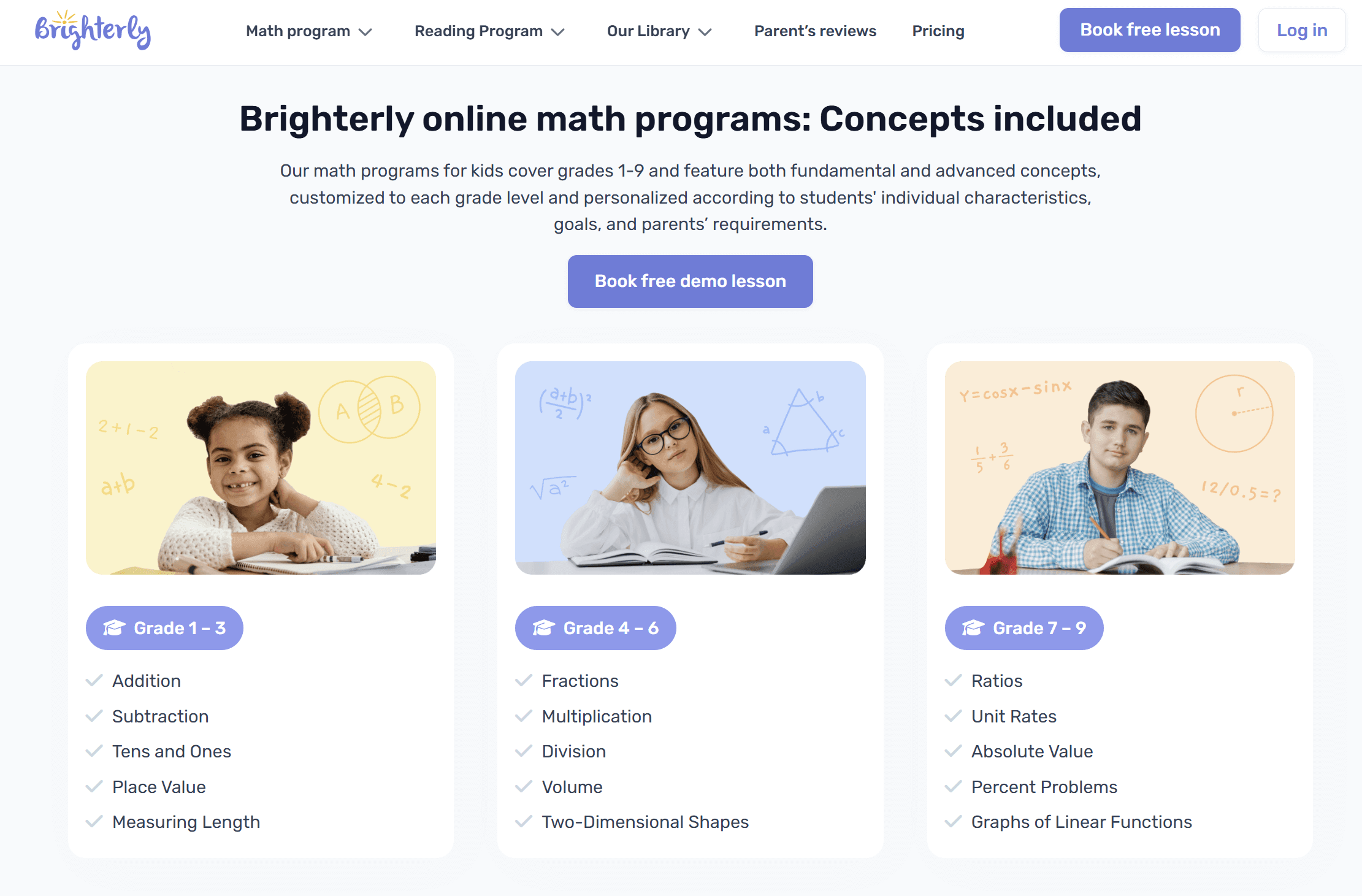Gender Gap in STEM Statistics 2025-2026
reviewed by Jo-ann Caballes
Updated on December 25, 2025
The gender gap in STEM, where girls and women are significantly underrepresented at multiple levels, remains a considerable problem. In this article, I’ll explore women in STEM stats that quantify the gap, key factors behind the persistent inequality, and steps to address the issue.
Key points
- Statistics of women in STEM show that women comprise 36% of STEM graduates and 28% of the STEM workforce.
- This is not only a grave social problem but also a reason for many missed opportunities.
- Building children’s math knowledge from a young age with 1:1 tutoring like Brighterly is the first step towards a successful STEM career.
What is the gender gap in STEM?
The STEM gender gap is a persistent imbalance between men and women in science statistics, technology, engineering, and mathematics fields, both in education and the workforce. Closing the gender gap in STEM requires a multi-faceted approach, like early education and outreach, addressing unconscious bias, and advocacy.
STEM gender gap examples
Gender gap in STEM examples include high-school girls showing less interest in advanced STEM subjects and fewer female students graduating in these disciplines. Other examples are fewer women holding leadership positions and female scientists being paid less than their male counterparts.
Global gender gap in STEM: How the US compares
The STEM gap is a universal problem. UNESCO reports that globally, for the last 10 years, women constituted 35% of STEM graduates. This is consistent with US statistics, where the percentage was 36% in 2015-16. In advanced nations, the share of female graduates in STEM fields is between 16% in Japan and 28% in France.
Moving post-graduation, in the US, women comprise approximately 28% of the STEM workforce, comparable to India (27%) and lower than the EU (52%).
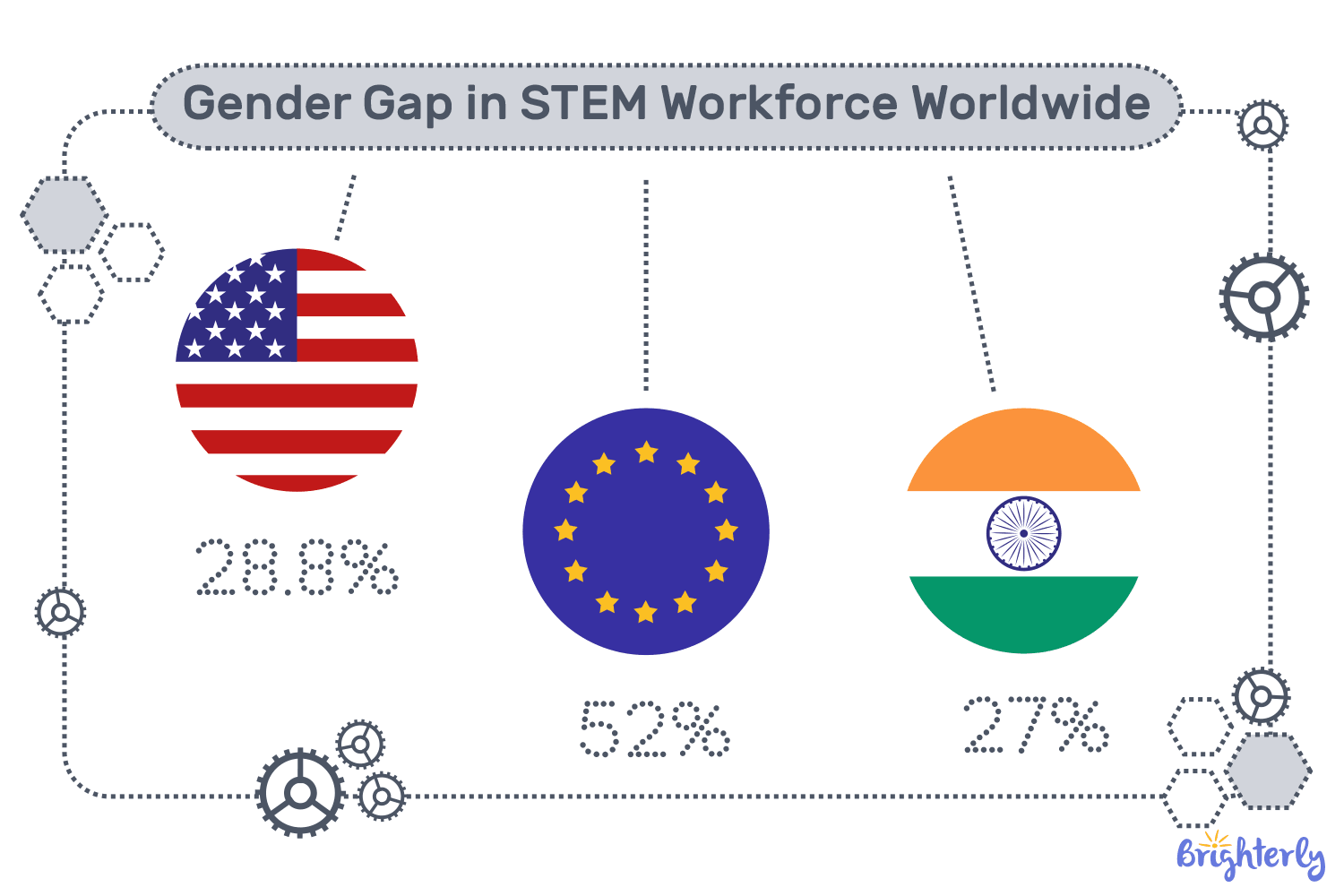
Gender gap in STEM statistics: US K-12 girls’ participation in STEM
While math and science are obligatory in grades K-12, differences between boys and girls start showing up early. At the age of 6, kids already perceive girls to be worse in computing and engineering than boys. The bias increases with age, driven by binary stereotypes rather than achievement. This pushes girls towards more traditional subjects, like humanities and languages.
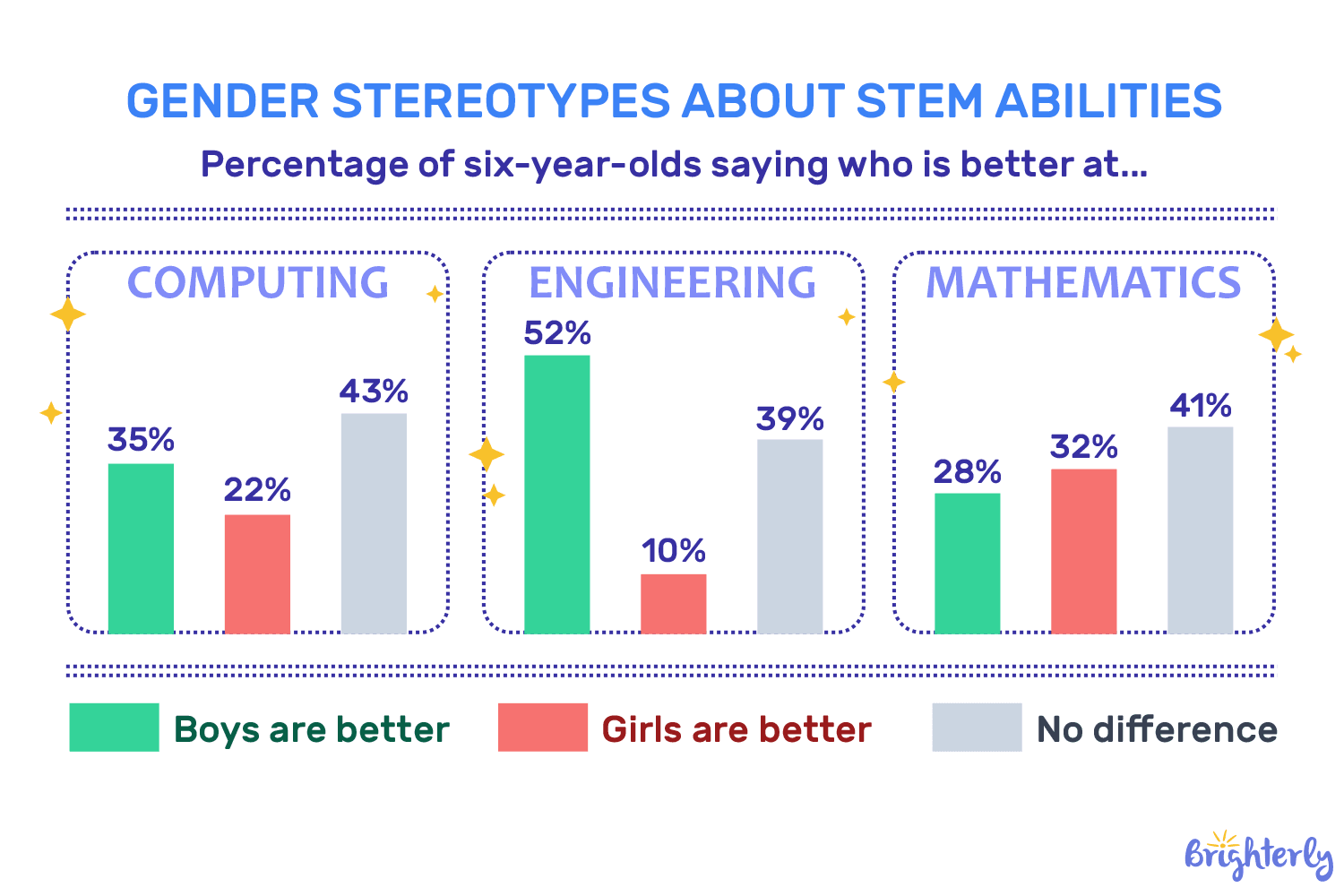
Not only students discriminate against each other. Educational institutions play a major role. Expert Shelley Gupta, founder of a homeschooling brand for kids, explains:
“For in-person schools especially, cooking and homemaker classes are pushed more towards girls, while other programs like wood shop, STEM-focused classes are pushed more for boys.”
For various reasons, girls’ participation in computer science, not compulsory in all states, declines with age. While at middle school, female students comprise 44% of enrollments in computer science, the number drops to 33% at high school.
Despite efforts, the STEM education gender gap still persists in 2025 and is likely to continue in 2026 and beyond.
SAT gender gap: 2020-2026
In 2017-2024, female students consistently underperformed compared to male students on the SAT math. The gap decreased from 22 points in 2017 to 15 points in 2025, but the performance of both genders dropped over this period.
Year |
Average SAT math score: Male |
Average SAT math score: Female |
Gender gap in SAT math score |
| 2017 | 538 | 516 | 22 |
| 2018 | 542 | 522 | 20 |
| 2019 | 537 | 519 | 15 |
| 2020 | 531 | 516 | 15 |
| 2021 | 537 | 519 | 18 |
| 2022 | 530 | 512 | 18 |
| 2023 | 515 | 500 | 15 |
| 2024 | 514 | 496 | 18 |
| 2025 | 515 | 500 | 15 |
Note: An article on the STEM gender gap in The New York Times argues that the gap doesn’t indicate girls’ poor math abilities, but rather girls’ greater interest in reading and the humanities. So, they center on these subjects at school and later pursue careers in related areas.
Workforce gender gap in STEM statistics
On the positive side, the percentage of women choosing STEM fields has risen since 2010, with 45% of STEM students now being women. Notable gains have also been achieved internationally in decreasing the gender gap in STEM 2022, as evidenced by the World Economic Forum 2022 Global Gender Gap Report, which shows an increase in women entering critical STEM career pathways worldwide. This suggests that the gender gap in STEM education is narrowing.
However, workforce disparity remains problematic. Upon completing a science-related degree, women face significant challenges in the workforce. In the US, women make up only 28% of STEM jobs. Moreover, up to 40% of women leave the technical workforce after just 5-7 years. Meanwhile, the male attrition rate is almost half, at 23%.
Even when women enter the workforce, including those with STEM backgrounds, many still struggle to climb the corporate ladder. Due to McKinsey’s Women in the Workplace 2025 report, women continue to be underrepresented at all levels: only 29% of C‑suite roles are held by women, and a persistent “broken rung” at the first promotion to manager holds back many early‑career women.
In some countries, women remain in STEM longer and comprise an important portion of the total workforce. For instance, in Central Asia, the percentage of female researchers ranges from 38% in Tajikistan to 53% in Kazakhstan.
Key factors for an unequal percentage of women in STEM
- Being undervalued
- Dismissive managers
- Alienation
- Gender pay gap
- Lack of career advancement
- Insufficient female role models
Being undervalued
A main reason for the unequal statistics about women in STEM is that women don’t feel valued and acknowledged in their roles. In general, 38% of women in the workforce report more or less subtle comments and patterns of disregard by (male) managers, colleagues, and even clients that make them feel invisible, disrespected, or not good enough. The percentage is even higher in male-dominated STEM industries.
Life is full of everyday situations where women are subjected to mistrust purely based on gender, as shared on Reddit.

Dismissive managers
As many as 69% of women working in STEM quit their jobs, citing a toxic work environment as a primary reason. Toxic manager and colleague behavior includes giving non-constructive feedback, denying access to key decisions, not inviting women to important meetings, failing to provide recommendations for promotions despite strong performance, and taking credit for work done by women. Some women even report their careers being deliberately sabotaged by managers.
Alienation
As STEM fields are male-dominated, women face alienation, isolation, and exclusionary behaviors. Women struggle to get their voices heard, leading to missed opportunities. Many women fail to overcome biased policies, processes, and mindsets among those holding power, forcing them to leave before building a career. This becomes one of the most notable STEM gender gap examples.
Gender pay gap
Another reason why women leave STEM is the discrepancy in remuneration based on gender rather than objective criteria, such as experience, qualifications, and skills. While the gender pay gap is a major problem in the US, at 6% in 2024, the situation is worse in STEM. The gender pay gap in science and in engineering is 13% and 10%, respectively. It’s only natural that young female scientists and engineers quit due to this injustice, as wage is the ultimate testament to how much someone is valued at their workplace.
Lack of career advancement
According to the Journal of Corporate Finance, the overall size of the gender promotion gap is calculated at 16%. The professional progress gender gap in STEM in an industry with so few female leaders and managers is higher. Women who can’t get used to male peers securing promotions in spite of being equally or less qualified leave the job.
Insufficient female role models
Young women and girls lack visible role models in STEM fields. That’s why female students find it hard to envision a successful future in the field. Thus, they choose to study something else even if they have an interest in sciences and technology. Later on, the absence of women in leadership and senior technical roles signals to young professionals that long-term success is unattainable and discourages them from remaining in STEM.
These factors drive girls to opt for humanities-based majors, young graduates to choose more traditional career paths, and women already working in STEM to discontinue. This reinforces the persistent gender gap in STEM education and careers.
Geillan Aly, Founder and CEO of Compassionate Math, shares insights on why women often turn away from STEM:
“Girls’ disengagement from STEM comes from many things, including the perception that being smart isn't cool/sexy for girls. Poor fit in terms of the perception of what a career in STEM looks like: can I have children and go into STEM, can I have a demanding job and be loved/have a personal life or a proper work-life balance with a career in STEM, can I be more successful than my potential partner?”
So what’s the best way to improve STEM gender gap statistics?
Change girls in STEM statistics for the better with 1:1 math tutoring
The easiest and quickest way to increase female participation and advancement in science and tech careers is to prepare young girls for a STEM-based job, working on their expertise and self-esteem. 1:1 tutoring has proven benefits in both regards.
The Brighterly math and reading platform provides private, online, real-time tutoring to grades 1-9. Starting at an early age allows kids to develop foundational skills in math and build advanced knowledge. After all, math is the basis for long-term success in STEM.
What features of the Brighterly reading and math program make it the best choice for STEM learning?
STEM-focused, customized curriculum
Brighterly supplies an award-winning math curriculum, which is aligned with the US state standards and STEM-focused. Math is studied through real-world examples that introduce children to the application of math concepts in science, computers, and other related fields.
Additionally, the learning plan and educational materials are individualized to each girl and boy. While both basic topics and advanced skills are covered, this happens at the pace and in the way that’s most appropriate for every learner.
Top-notch tutors
Another reason why Brighterly contributes to closing the gender gap in STEM is the quality of tutors. All Brighterly math tutors have a Bachelor’s degree or higher and 5+ years of teaching experience. Parents’ reviews on Trustpilot consistently highlight tutors’ professionalism, patience, and positive attitude which is crucial in the fight against dooming women in STEM percentage 2025.

Affordable pricing
On top of high quality, Brighterly offers an affordable price for 1:1 tutoring. The cost starts at $17.30/lesson (12-month subscription, 3 lessons/week). This is well below the standard tutoring rates per hour of $20-$80 in the US.
Free materials
To further boost value, the platform offers free access to math worksheets and reading worksheets. They’re easy to print so kids don’t spend extra time in front of the screen. Meanwhile, they offer real-life examples that teach children how to apply math skills in practice and why it’s important to excel in this subject.
Free math tests are also available to test your kid’s knowledge and see in which area they need the most support for future STEM education.
Statistics on how the gender gap in STEM affects girls’ future earnings
STEM workers earn an average of 29% more than other occupations (2017), but women in STEM earn only 74% of what men make (2021). While this marks an improvement from 72% in the pay gender gap in STEM in 2016, it still emphasizes one of the main aspects of equality in science, technology, and math.

To put these numbers into perspective, if parents have a boy and a girl who graduate in STEM-related areas, the girl’s expected to make 74 cents for every dollar that her brother earns. This statistic alone is enough to discourage young girls from pursuing careers in modern fields and focus on more traditional, less demanding professions.
But this significant gender pay gap has an even more detrimental effect. It’s one of the many reasons why girls suffer from lack of confidence as the world continuously tries to make them believe they are less valuable than boys. It comes as no surprise that at the age of 6, girls start seeing themselves as “really, really smart” less often than boys and begin to avoid activities set for “really, really smart” children.
In this way, girls are pushed towards more conventional jobs that, as mentioned, make less than STEM positions. So, it’s not only that women get paid less than men in the same job, but they choose ones that already pay less than others.
Statistics on parents’ involvement in school STEM programs
Parents, as role models, can have a major impact on kids’ participation in STEM disciplines. Indeed, parental involvement could be a key to solving the men vs women in STEM problem if parents encourage their daughters to consider such a career.
Despite this potential, only 38% of elementary schools, 21% of middle schools, and 6% of high schools hold family math nights. This shows a need to increase efforts to incorporate parents’ in STEM education.
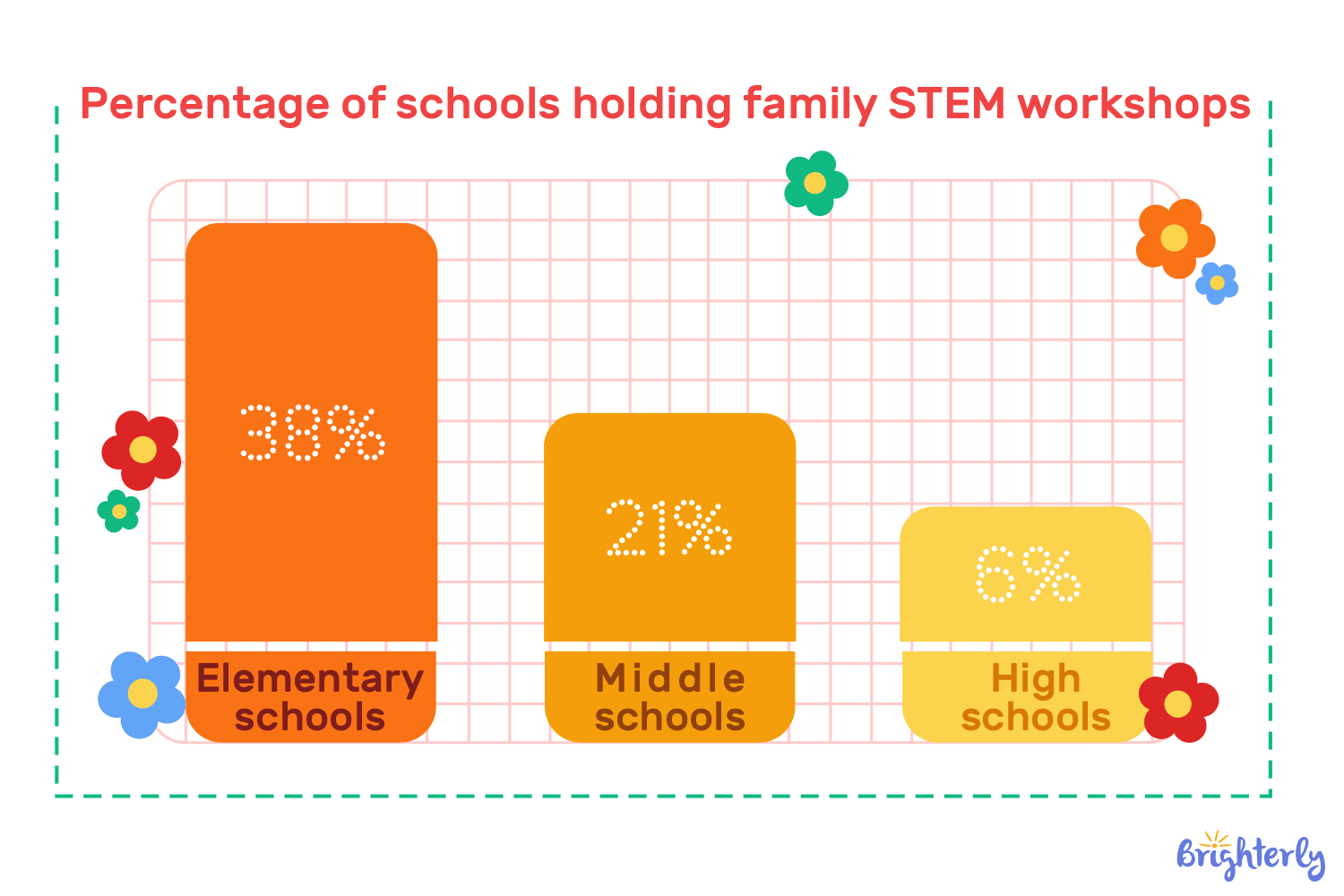
Meanwhile, 76% of parents say that after-school STEM programs for kids enhance their kids’ interest and skills in STEM. Parents’ involvement in such programs could help even more in sparking girls’ interest.
When it comes to bringing more girls into STEM, Advances in Life Course Research shows that mothers hold significantly more power to motivate their daughters to study sciences and computers and pursue a career in STEM than fathers. Similarly, women working in STEM are less likely to impose gender-based job stereotypes on their kids. These are important considerations regarding the intergenerational transmission of STEM professions.
Gender gap in STEM 2020-2026
When discussing disparities, it’s important to pay close attention to STEM education gender gap statistics.
STEM education gender gap
According to the STEM education gender gap 2020, in the US, women earned 42% of bachelor’s degrees in mathematics or statistics, 25% in physics, and 23% in engineering. These numbers show gradual increases from previous decades. Let’s track the trajectory afterwards to understand women participation in STEM fields 2025 statistics.
Stem education gender gap 2020 |
In 2011-2020, the number of S&E degrees earned by women increased by 63% at the associate’s, 34% at the bachelor’s, 45% at the master’s degree, and 18% at the doctorate level. |
Stem education gender gap 2021 |
In the academic year of 2020-2021, about 860,760 male and 1.2 million female students earned a Bachelor’s degree in the US. |
Stem education gender gap 2022 |
The 2022 Gender Gap Report shows that gender segregation within STEM education continues. |
Stem education gender gap 2023 |
48% of parents with daughters discussed STEM topics with their kids at least once a week, from 42% in 2020-2021. |
Stem education gender gap 2024 |
Girls comprised about a quarter of enrolments in year 12 information technology, physics, and engineering classes. |
Stem education gender gap 2025 |
In 2025, globally, women account for 35% of STEM graduates. |
STEM workforce gender gap
According to women in STEM statistics 2025, women comprise 28% of the STEM workforce. This figure saw minimal improvement over the past decade, and the same goes for STEM education gender gap statistics. A positive sign is the fact that between 2011 and 2021, the percentage of women working in STEM increased faster than men’s.
COVID-19 pandemic impact on the percentage of women in STEM
The COVID-19 pandemic worsened existing gender gaps in the sphere of education. Girls experienced more significant learning losses in mathematics and science than boys.
What is the gender gap in STEM majors?
The STEM education gender gap 2025 in the USA persists at all levels, including graduate. While girls account for 35% of STEM graduates, there are differences between subjects.
Engineering |
Computer Science |
Life and Physical Sciences |
| 16% | 26% | 45% |
Note: Despite alarming women-in-science statistics, women have already earned the majority of bachelor’s, master’s, and doctoral STEM degrees in some recent years.
Which STEM field shows the smallest gender gap?
Although women are underestimated in many STEM fields, like biological sciences, chemistry, and materials science, as well as web and digital interface design and physical sciences, these fields exhibit the smallest gender gaps, at 58%, 46%, 44%, and 43%, respectively.
What percentage of STEM students are female in the biggest gender gap subjects?
The biggest discrepancies are observed in engineering, computer science, and physics, where only 15%, 25%, and 24% of participants are women.
However, these numbers at the educational level are only part of the story — industry choice and workplace structure matter, too. As McKinsey notes, women who navigate toward growing industries and companies are more likely to find sustainable career paths, rather than staying in shrinking or unstable sectors.
Why is there a gender gap in STEM?
- Stereotypes
- Lack of obvious role models
- Bias in education and hiring
- Workplace culture and retention issues
- Access to resources and support
Understanding disproportionate women in STEM statistics
Many factors drive women outside a STEM career despite the efforts required to get there. The main ones include toxic work culture, discrimination by leadership and peers, and limited advancement opportunities.
The traditional role of women in the family also plays a role. While 42% of women leave their full-time careers after the birth of their first child, the number is only 15% for men.
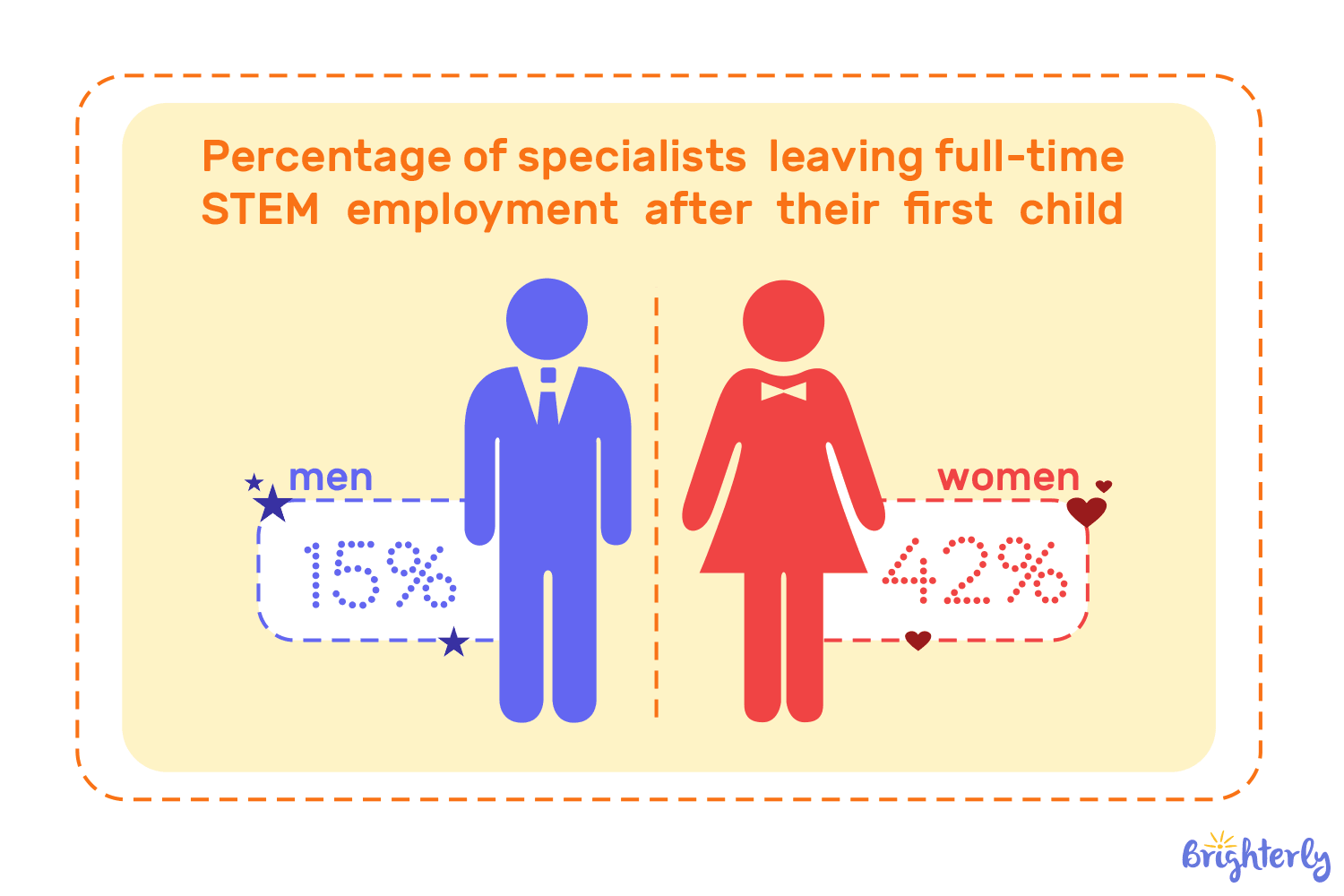
Why is gender equality in STEM important?
The percentage of women in STEM is not only about fairness. Providing access based on expertise and skills rather than gender can lead to important tech developments while adding trillions of dollars to the international economy. Securing gender equity is not only fair but also smart.
How to fix the gender gap in STEM?
- Introduce crucial subjects early, and encourage girls to pursue STEM-related education.
- Promote visible female role models and increase leadership representation at all levels.
- Address structural barriers such as the gender pay gap, lack of family-friendly policies, and gender bias.
- Create inclusive workplaces and address unconscious biases.
- Support women to stay in STEM careers by offering mentorships and support programs.
- Provide professional development opportunities.
Hannah Hagon, author and expert on how to turn play into lifelong thinking skills, shares the following ideas to increase girls’ participation:
“Building foundational computational thinking skills through guided unplugged play activities utilising craft, movement, everyday items and familiar topics encourages girls' interest and confidence in STEM.”
Conclusion: Fighting the gender inequality in STEM
The gender gap in STEM is an ongoing problem despite minor improvements in recent years. The solution requires a multifaceted systemic approach that removes the root causes of the issue. We have the collective opportunity to empower women to choose their educational tracks and career paths, unlocking the full potential of STEM-related industries for women and improving women in STEM statistics 2023-2026 and beyond.
If you’re looking for a platform to enhance your child’s STEM education, check out Brighterly.
With the Brighterly math program, you get:
✅ Customized math learning
✅ Professional tutors
✅ Affordable pricing
Ready to support your child’s future career in STEM? Book free lesson now to try the power of 1:1, personalized math tutoring.




